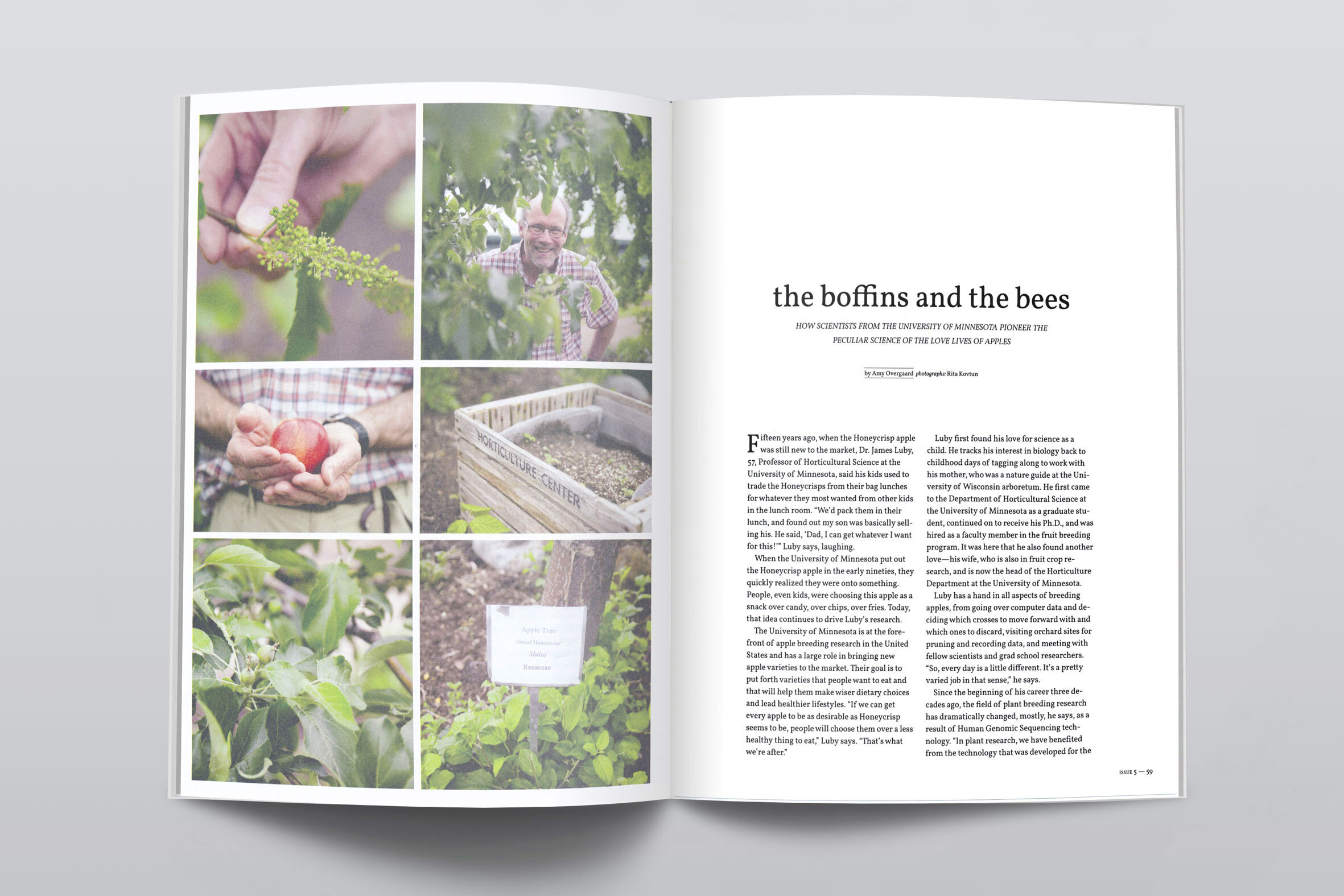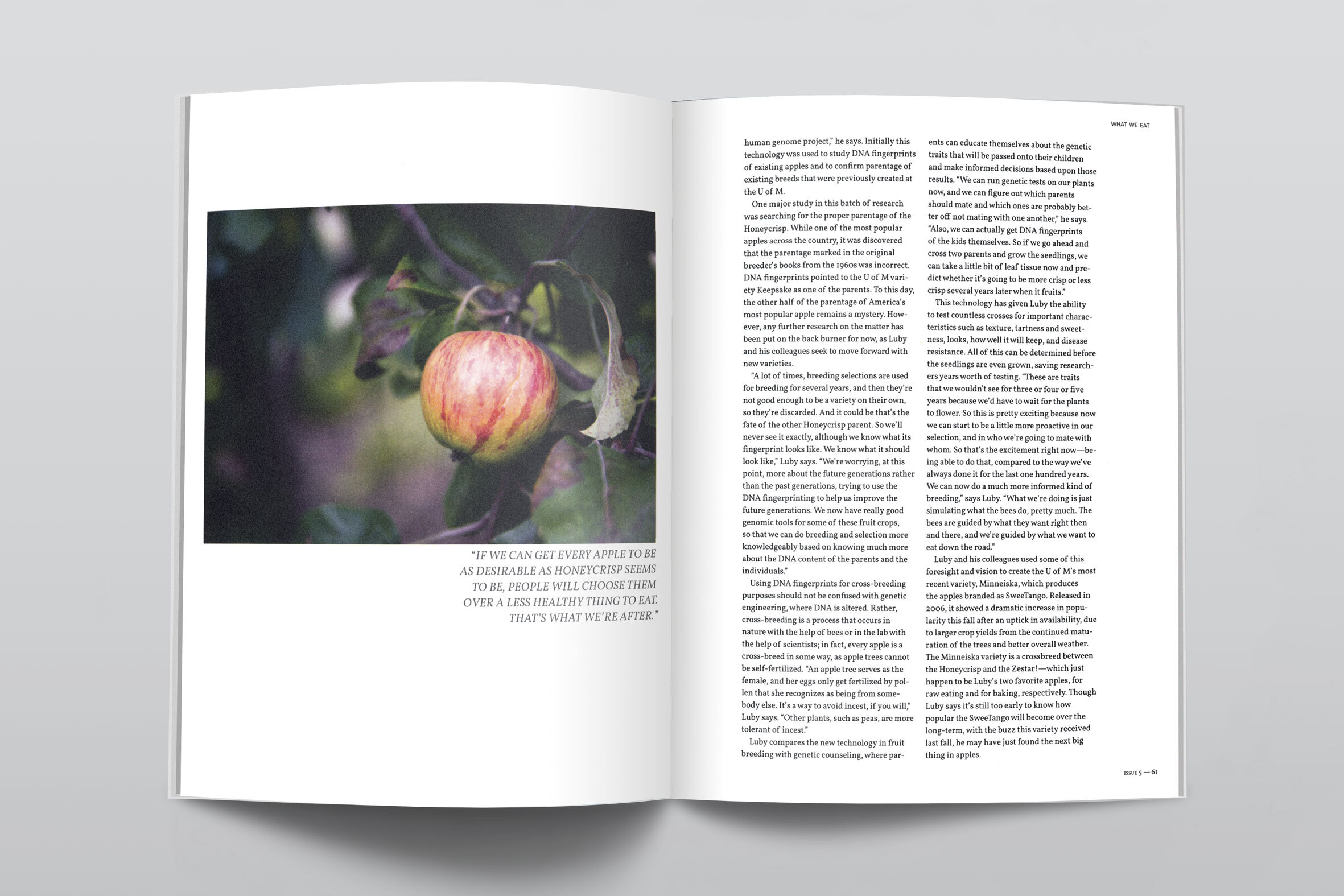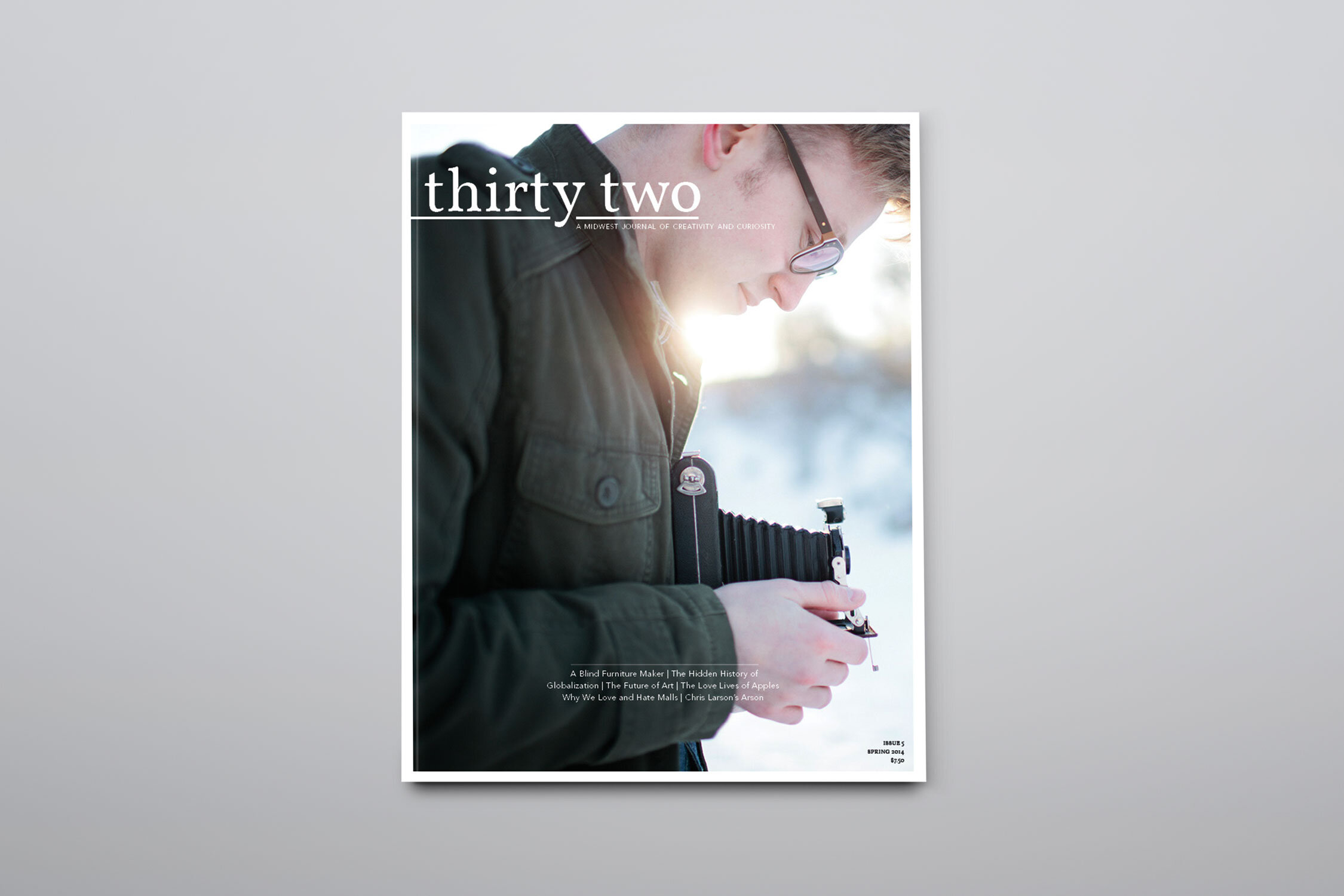The Boffins and the Bees
Thirty Two, Issue 5
The Boffins and the Bees
How Scientists from the University of Minnesota pioneer the peculiar science of the love lives of apples.
Fifteen years ago, when the Honeycrisp apple was still new to the market, Dr. James Luby, 57, Professor of Horticultural Science at the University of Minnesota, said his kids used to trade the Honeycrisps from their bag lunches for whatever they most wanted from other kids in the lunch room. “We’d pack them in their lunch, and found out my son was basically selling his. He said, ‘Dad, I can get whatever I want for this!’” Luby says, laughing.
When the University of Minnesota put out the Honeycrisp apple in the early nineties, they quickly realized they were onto something. People, even kids, were choosing this apple as a snack over candy, over chips, over fries. Today, that idea continues to drive Luby’s research.
The University of Minnesota is at the forefront of apple breeding research in the United States and has a large role in bringing new apple varieties to the market. Their goal is to put forth varieties that people want to eat and that will help them make wiser dietary choices and lead healthier lifestyles. “If we can get every apple to be as desirable as Honeycrisp seems to be, people will choose them over a less healthy thing to eat,” Luby says. “That’s what we’re after.”
Luby first found his love for science as a child. He tracks his interest in biology back to childhood days of tagging along to work with his mother, who was a nature guide at the University of Wisconsin arboretum. He first came to the Department of Horticultural Science at the University of Minnesota as a graduate student, continued on to receive his Ph.D. ., and was hired as a faculty member in the fruit breeding program. It was here that he also found another love—his wife, who is also in fruit crop research, and is now the head of the Horticulture Department at the University of Minnesota.
Luby has a hand in all aspects of breeding apples, from going over computer data and deciding which crosses to move forward with and which ones to discard, visiting orchard sites for pruning and recording data, and meeting with fellow scientists and grad school researchers. “So, every day is a little different. It’s a pretty varied job in that sense,” he says.
Since the beginning of his career three decades ago, the field of plant breeding research has dramatically changed, mostly, he says, as a result of Human Genomic Sequencing technology. “In plant research, we have benefited from the technology that was developed for the human genome project,” he says. Initially this technology was used to study DNA fingerprints of existing apples and to confirm parentage of existing breeds that were previously created at the U of M.
One major study in this batch of research was searching for the proper parentage of the Honeycrisp. While one of the most popular apples across the country, it was discovered that the parentage marked in the original breeder’s books from the 1960s was incorrect. DNA fingerprints pointed to the U of M variety Keepsake as one of the parents. To this day, the other half of the parentage of America’s most popular apple remains a mystery. However, any further research on the matter has been put on the back burner for now, as Luby and his colleagues seek to move forward with new varieties.
“A lot of times, breeding selections are used for breeding for several years, and then they’re not good enough to be a variety on their own, so they’re discarded. And it could be that’s the fate of the other Honeycrisp parent. So we’ll never see it exactly, although we know what its fingerprint looks like. We know what it should look like,” Luby says. “We’re worrying, at this point, more about the future generations rather than the past generations, trying to use the DNA fingerprinting to help us improve the future generations. We now have really good genomic tools for some of these fruit crops, so that we can do breeding and selection more knowledgeably based on knowing much more about the DNA content of the parents and the individuals.”
Using DNA fingerprints for cross-breeding purposes should not be confused with genetic engineering, where DNA is altered. Rather, cross-breeding is a process that occurs in nature with the help of bees or in the lab with the help of scientists; in fact, every apple is a cross-breed in some way, as apple trees cannot be self-fertilized. “An apple tree serves as the female, and her eggs only get fertilized by pollen that she recognizes as being from somebody else. It’s a way to avoid incest, if you will,” Luby says. “Other plants, such as peas, are more tolerant of incest.”
Luby compares the new technology in fruit breeding with genetic counseling, where parents can educate themselves about the genetic traits that will be passed onto their children and make informed decisions based upon those results. “We can run genetic tests on our plants now, and we can figure out which parents should mate and which ones are probably better off not mating with one another,” he says. “Also, we can actually get DNA fingerprints of the kids themselves. So if we go ahead and cross two parents and grow the seedlings, we can take a little bit of leaf tissue now and predict whether it’s going to be more crisp or less crisp several years later when it fruits.”
This technology has given Luby the ability to test countless crosses for important characteristics such as texture, tartness and sweetness, looks, how well it will keep, and disease resistance. All of this can be determined before the seedlings are even grown, saving researchers years worth of testing. “These are traits that we wouldn’t see for three or four or five years because we’d have to wait for the plants to flower. So this is pretty exciting because now we can start to be a little more proactive in our selection, and in who we’re going to mate with whom. So that’s the excitement right now—being able to do that, compared to the way we’ve always done it for the last one hundred years. We can now do a much more informed kind of breeding,” says Luby. “What we’re doing is just simulating what the bees do, pretty much. The bees are guided by what they want right then and there, and we’re guided by what we want to eat down the road.”
Luby and his colleagues used some of this foresight and vision to create the U of M’s most recent variety, Minneiska, which produces the apples branded as SweeTango. Released in 2006, it showed a dramatic increase in popularity this fall after an uptick in availability, due to larger crop yields from the continued maturation of the trees and better overall weather. The Minneiska variety is a crossbreed between the Honeycrisp and the Zestar!—which just happen to be Luby’s two favorite apples, for raw eating and for baking, respectively. Though Luby says it’s still too early to know how popular the SweeTango will become over the long-term, with the buzz this variety received last fall, he may have just found the next big thing in apples.
This article was re-published on MinnPost.



